

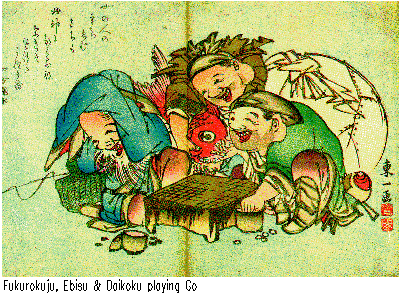
Contents
Introduction
Description and Rules
A Brief History of Go
Chess and Go
Go on the Internet
This page explores the ancient oriental game of go. Although it is played widely in China, Korea, and Japan, the game is relatively unknown outside of the orient. Go has become more popular in recent years among western players, especially since the appearance of go servers that make it possible to play the game over the internet. On this page you will find a description of the game and a discussion of the rules, a brief history of this game, and resources available to the player on the internet.
Go is played on a grid of 19 x 19 lines, creating 361 intersections, or "points". Traditional Japanese boards are fashioned from wooden blocks measuring roughly 18" long x 16" wide x 5" thick. The boards are supported on 3" high feet at each corner. Boards and feet are stained yellow. The grid lines are marked in black lacquer. The board is hollowed out to reduce its weight, and to increase the resonance of the clicking sound made when a piece is placed on the board, which adds to the enjoyment of the game. Korean players have added a further refinement, stretching wires beneath some of their boards to produce a musical tone when a piece is played.
The gaming pieces are ovoid disks about 7/8" in diameter, and are referred to as stones (tze in Chinese, or ishi in Japanese). In the best sets, the white stones are carved from shell, and the black from slate. Less expensive sets use glass. Black has 181 stones, while white has 180. The stones are stored in carved or turned wooden bowls.
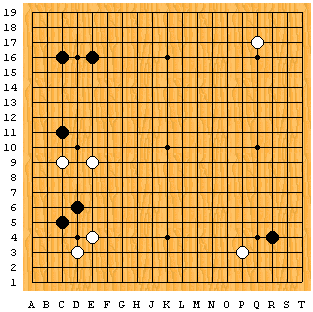 Players are seated on the floor, facing each other across the empty board. Black plays first, placing a stone at the intersection of one of the points of the grid, followed by white. The players alternate their placement of the stones. Once a stone is placed, it is not moved, although it can be captured. The diagram at the right shows a game in progress following white's 6th placement.
Players are seated on the floor, facing each other across the empty board. Black plays first, placing a stone at the intersection of one of the points of the grid, followed by white. The players alternate their placement of the stones. Once a stone is placed, it is not moved, although it can be captured. The diagram at the right shows a game in progress following white's 6th placement.
The object of the game is to control "territory", or vacant points, with your stones, placing them in such a way that your opponent cannot viably occupy those points. The player in control of the most territory at the end of the game is the winner. As can be seen from the diagram, play usually begins in the corners and along the sides, as these points are easier to control than points in the center of the board. For example, the corner point a1 can be completely surrounded by three stones placed at a2, b1, and b2. To surround a single point in the center of the board would require 8 stones.
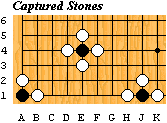 A stone which has been completely surrounded on the adjacent orthagonal points by an opponent's stones is captured and lifted from the board. Stones on orthagonal adjacent points are connected, or grouped.
A stone which has been completely surrounded on the adjacent orthagonal points by an opponent's stones is captured and lifted from the board. Stones on orthagonal adjacent points are connected, or grouped. 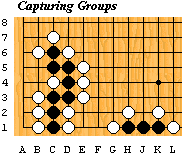 These groups survive or are captured as a unit. In the figure to the right, white captures the black groups by playing at b5 and j2. If it were black's turn to place, he could capture the white stone at c4 by placing at b4. It should be noted that the object of the game is not to capture stones, but to control territory, just as in chess the object is not to capture pieces, but to checkmate the king. In both go and chess, it is possible to complete a game without making a single capture. In go, a player who concentrates on capturing his opponent's stones is liable to find all of the remaining free territory on the board controlled by his opponent.
These groups survive or are captured as a unit. In the figure to the right, white captures the black groups by playing at b5 and j2. If it were black's turn to place, he could capture the white stone at c4 by placing at b4. It should be noted that the object of the game is not to capture stones, but to control territory, just as in chess the object is not to capture pieces, but to checkmate the king. In both go and chess, it is possible to complete a game without making a single capture. In go, a player who concentrates on capturing his opponent's stones is liable to find all of the remaining free territory on the board controlled by his opponent.
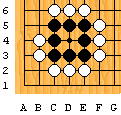 A stone cannot "commit suicide"; that is, it cannot be placed on a point that would result in its capture, unless by doing so a capture is made. In the diagram to the left, white cannot play at d4, as this point is controlled by black. However, if white first places a stone at b5, he can then place d4 on the next move, as this would capture all of the black stones.
A stone cannot "commit suicide"; that is, it cannot be placed on a point that would result in its capture, unless by doing so a capture is made. In the diagram to the left, white cannot play at d4, as this point is controlled by black. However, if white first places a stone at b5, he can then place d4 on the next move, as this would capture all of the black stones.
 A vacant point completely surrounded on all adjacent orthagonal points by a player's stones is called an "eye" (occupation of points on the diagonal do not count in this assessment, although such occupation can solidify a position, when necessary). Since a stone cannot be placed in an eye unless a capture is made, any group having at least two eyes is secure from capture. In the diagram, black has eyes at p3 and r3. This group can therefore not be captured. However, beware of false eyes! If black had not played a stone at o2, white could play a stone there, and then capture the three black stones at o3, o4, and p4 on the next move by playing at p3. The rest of the group would then fall.
A vacant point completely surrounded on all adjacent orthagonal points by a player's stones is called an "eye" (occupation of points on the diagonal do not count in this assessment, although such occupation can solidify a position, when necessary). Since a stone cannot be placed in an eye unless a capture is made, any group having at least two eyes is secure from capture. In the diagram, black has eyes at p3 and r3. This group can therefore not be captured. However, beware of false eyes! If black had not played a stone at o2, white could play a stone there, and then capture the three black stones at o3, o4, and p4 on the next move by playing at p3. The rest of the group would then fall.
In actual play, when the capture of a group of stones is inevitable, a player will usually not waste a move to make the capture unless his own surrounding stones were endangered. The stones will usually remain on the board until the end of the game, at which point they would be declared "dead" and removed from the board.
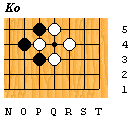 A repeating position, called a ko, is possible during play. In the diagram, the stones are interlocked in such a way as to make perpetual captures possible. Black plays at q4, capturing the stone at p4. In this position, to avoid perpetual captures, white is required to play a move elsewhere before playing at p4. This gives black the opportunity, if he wishes, to fill the point at p4 before white's next turn. If he does not, and white plays p4 on his next available move, then black must play elsewhere before playing again at q4. Each player may attempt to force his opponent to play elsewhere on the board by making threats, so that the opponent must respond to the threat rather than filling the ko. This is what is known as a "ko fight." If there are three ko positions on the board, the game is considered drawn.
A repeating position, called a ko, is possible during play. In the diagram, the stones are interlocked in such a way as to make perpetual captures possible. Black plays at q4, capturing the stone at p4. In this position, to avoid perpetual captures, white is required to play a move elsewhere before playing at p4. This gives black the opportunity, if he wishes, to fill the point at p4 before white's next turn. If he does not, and white plays p4 on his next available move, then black must play elsewhere before playing again at q4. Each player may attempt to force his opponent to play elsewhere on the board by making threats, so that the opponent must respond to the threat rather than filling the ko. This is what is known as a "ko fight." If there are three ko positions on the board, the game is considered drawn.
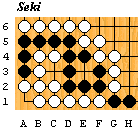 Groups of stones may also become interlocked in such a way as to cause an impasse, in which neither player can gain advantage. This situation, called seki, is illustrated by the figure to the right. Neither player can place at c3 without losing his own group by the opposing player's next placement. The vacant point (or points) between the groups are considered neutral, and are credited to neither player.
Groups of stones may also become interlocked in such a way as to cause an impasse, in which neither player can gain advantage. This situation, called seki, is illustrated by the figure to the right. Neither player can place at c3 without losing his own group by the opposing player's next placement. The vacant point (or points) between the groups are considered neutral, and are credited to neither player.
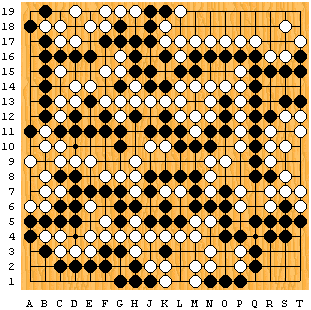 A player may pass his turn instead of placing a stone. This will not normally happen until the end of the game, when there are no more profitable plays to be made. When three consecutive passes have been made, the game is over, and the players begin scoring. The players begin by removing all of the dead stones from the board, then by filling the opponent's vacant spaces with captured stones. It doesn't matter where these stones are placed within enemy territory, as new captures cannot be made while scoring. All neutral points are then filled in. The players then count the remaining vacant spaces, and compare the tallies. The highest score wins. The diagram at the left shows a final position. In this case, seeing that he was lost, the white player had resigned the game before all of the frontiers between the opposing groups had been filled in. If the game had continued to its conlusion, and the score tallied, black would have won the game by a margin of about 11 points (black had captured and removed five stones during the game, while white had captured and removed 2).
A player may pass his turn instead of placing a stone. This will not normally happen until the end of the game, when there are no more profitable plays to be made. When three consecutive passes have been made, the game is over, and the players begin scoring. The players begin by removing all of the dead stones from the board, then by filling the opponent's vacant spaces with captured stones. It doesn't matter where these stones are placed within enemy territory, as new captures cannot be made while scoring. All neutral points are then filled in. The players then count the remaining vacant spaces, and compare the tallies. The highest score wins. The diagram at the left shows a final position. In this case, seeing that he was lost, the white player had resigned the game before all of the frontiers between the opposing groups had been filled in. If the game had continued to its conlusion, and the score tallied, black would have won the game by a margin of about 11 points (black had captured and removed five stones during the game, while white had captured and removed 2).
These are the basic rules; as for tactics, here are a few hints:
![[Contents]](../../utility/duarrow.gif)
Go was popularized and spread abroad by the Japanese, and it is the Japanese rules that predominate in international play. For this reason, the game is best known by its Japanese name, even though the game was invented in China, and was played there for centuries prior to its introduction to Japan. In China the game is called wei-ch'i; in Korea, where it is also popular, it is called pa-tok.
As with chess, a legendary antiquity is claimed for this game. It is said to have been invented by the emperor Yao in 2,300 BC, which would place it 800 years prior to the Shang Dynasty, the oldest of the Chinese dynasties on record. The earliest mention of the game was in writings from Honan, dating from 625 BC, almost 1,000 years prior to the first textual references to chess. The first books written on wei-ch'i date from the Tang dynasty (AD 618-906).
The game was exported to Japan during the rein of the Empress Suiko c. AD 500. By the 11th century the game was being played throughout Japan, and by the 13th century it was popular with the samurai class. Game boards and pieces were regarded as military equipment, and were taken on campaign. An academy funded by the Japanese government was formed in the 16th century for the study and tuition of the game. Private schools and travelling masters also became common. Nine degrees of professional competence were recognized and awarded by the academy. The first and lowest degree carried the title "shodan", while the ninth degree - rarely awarded - was "kudan". A system of handicapping was also inaugurated during this era.
The game in Japan underwent something of a renaissance in the first half of the ninteenth century, but the fall of the Tokugawa Shogunate in 1868 resulted in the end of the Go Academy. The game and its masters fell on hard times for a number of years, as interest in western goods and customs spread across Japan, and indiginous arts and pursuits were neglected. The game underwent a revival in 1880, and today the number of players in Japan exceeds eight million. International go tournaments in Japan were inaugurated in 1963.
Go seems not to have undergone the amount of mutation and diversification peculiar to chess. This may be a function of the simplicity of the rules, and the limited area within which it spread. Older Chinese sources refer to smaller grid sizes (17 x 17). The rules from China to Japan differ only in scoring techniques - the Chinese count the points occupied by stones as a part of the tally, whereas the Japanese only count the vacant points enclosed. Usually this amounts to a relative difference in the scores of only one or two points.
A number of subsidiary games have evolved from wei-ch'i and go, similar to the evolution of the various draughts games from chess. These include go-moku, two varieties of hasami shogi, and a Korean draughts game called nei-pat-ko-no.
Chess and go are both fascinating games, and are almost completely opposite in their approach to modeling conflict. Chess is a game of personalities, in which the object is to capture the person of the king. The pieces possess different powers, and exert force across the board in various ways. The amount of force each individual piece can exert is not merely a function of its moves, but of its position on the board.
Go, on the other hand, is a fight for territory. All of the soldiers are identical in power, and gain their strength from the way in which they are grouped by their general (the player). The rules are simple in outline, but complex in execution. The intricacy of the game is further enhanced by the fact that individual combats in various portions of the board will gradually expand and have significant effect on battles taking place in other quarters.
If the games of a civilization can be considered a microcosm of the culture, the differences between the games and their objects may well indicate differences in the personalities of their players, and the aims of the various groups that played them. In both China and Japan, go existed alongside local versions of chess. In centuries past, chess in China was the favored game of the middle and lower classes, whereas wei-ch'i was played by the intelligentsia (Bell). In Japan the situation was opposite, with the intellectual class favoring chess, and go being the game of the populace (Falkener). The objects of these games may serve as an index to the thoughts concerning war of the people who played them, in an age where warfare was a far more common and everyday experience of the people than it is today.
I don't intend to compare the relative merits of chess and go. I've encountered a great deal of fruitless speculation over which game is more complex and challenging. Having played both, my feeling is that, for all practical purposes, the two games are identical in their complexity, and that nothing can be gained by arguing between them other than a rather juvenile assumption of superiority. Both are well worth learning to play, and your preference of one over the other may well reflect your own attitudes concerning conflict. Or not.
Using search engines to find pages on go can be an adventure. Obviously, a keyword search for "go" will turn up millions of pages, the majority of which will have nothing to do with game. As most search engines will allow you to search for phrases enclosed by quotes, you'll have much greater success searching with the phrase "game of go". Using "wei-ch'i" also works, but I've seen the term spelled three or four different ways. Your best bet is to find a go page (like this one), and hope that it has links to other go pages (like this one).
For information on the game, the best resources I have found are Jan van der Steen's Go Page, and a commercial site called Samarkand. The largest go server on the net is the Internet Go Server; from their web page you can find out how to connect to their server.
As with chess servers, you'll want to download a graphic client interface, many of which are available from the IGS FTP site. Once there, click to the subdirectory relevant to your system (eg - /PC for Windows and DOS clients). My preference is WinIGC, which is built to work on windows platforms. You'll want to download the 16 bit version for Windows 3.x, or the 32 bit version for Windows 95. WinIGC comes packaged with WinMgt, a program for viewing and reviewing stored games. I used this program to build the figures shown above in the rules section. WinIGC is shareware.